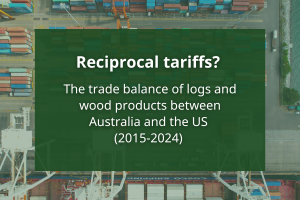Australia’s local sawn softwood sales are within sight of the all-time record, hitting 3.066 million m3 year-ended June 2021. The record of 3.173 million m3 was reached in 2018. But for all that the gap of just over 107,000 m3 is within sight, the sector is straining, but may not currently have the capacity to reach a new record.
The chart below shows reported sales over the decade, and points to the prospect that production may already be close to capacity.

To go straight to the dashboard and take a closer look at the data, click here.
It is well understood that stimulus and low interest rate fuelled housing demand has created an historically rapid surge in demand for sawn timber. The sharp spike in demand has stretched the supply chain, which allows for ongoing observation to its elasticity or responsiveness.
Latest data provides what may be the clearest indication yet that the sawn softwood supply chain is at or around its theoretical capacity.
The chart below shows annualised sawn softwood sales on a monthly basis since the onset of the pandemic. In fact, it appears that annualised sales peaked in February 2021 at 3.143 million m3, and have come off their peak in recent months.

To go straight to the dashboard and take a closer look at the data, click here.
So, as local producers work to take up the strain, why can we see the total volumes coming under pressure?
First, when supply chains are stretched and already at their maximum, they can only head down. Perhaps that is happening in this instance as the supply chain races to keep up and bottle-necks emerge.
Second, despite the emphasis on structural softwood right now, as the industry stretches to build the nation’s surging housing demand, the last decade has seen the proportion of structural products decline. In 2010, structural grades accounted for 58.5% of the total sawn softwood production, declining to 48.5% in 2020. We can see this below.

Source: FWPA & IndustryEdge
There are plenty of potential drivers for this change over time. Better utilisation of resource allowing for more products to be derived from the same log volumes, average smaller dimension logs and possibly some higher producer margins for some grades or product groups (outdoor/external and packaging, in particular).
We can see this below, to some extent, where the combined structural grades saw sales lift 4.3% over the year-ended June 2021, compared with the prior year. That compares with the sharp 14.9% growth in sales of Outdoor Domestic products and the 9.3% growth in sales of the Packaging grades.
|
2020M06 |
2021M06 |
% Change |
|
|
Outdoor Domestic |
264,907 |
304,326 |
14.9% |
|
Fencing |
100,652 |
111,492 |
10.8% |
|
Appearance |
16,120 |
23,377 |
45.0% |
|
Structural < 120mm |
717,153 |
686,950 |
-4.2% |
|
Structural > 120mm |
58,295 |
60,084 |
3.1% |
|
Treated Structural < 120mm |
620,772 |
699,678 |
12.7% |
|
Treated Structural > 120mm |
49,837 |
61,548 |
23.5% |
|
Landscaping |
133,472 |
124,177 |
-7.0% |
|
Poles |
39,068 |
35,424 |
-9.3% |
|
Packaging |
592,317 |
647,381 |
9.3% |
|
Ungraded |
267,926 |
234,159 |
-12.6% |
|
Export |
110,848 |
77,771 |
-29.8% |
|
Total |
2,971,367 |
3,066,367 |
3.2% |
Lower grade and more discretionary products like Ungraded (-12.6%) and Export (-29.8%) took the brunt of the shift in sales, while the data overall demonstrates an apparent preference among producers toward the Outdoor and Packaging grades.
Having turned to face the strain, the entire domestic supply chain is doing what it can to meet the rapid change in housing demand. We’ll all be watching closely these coming months to see what further changes the market brings about – and how the sector turns to take that strain.
* Apologies to David Bowie



